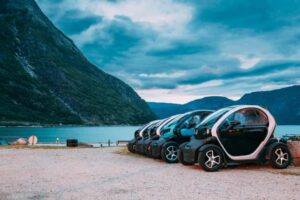
I’m kneeling on the snow outside the king’s house, impersonating a 1980s heart-throb, with a man named Harald and an electric car. It’s a situation that probably needs some explanation.
Harald isn’t the king, although the king of Norway is also called Harald; we just happen to be outside the monarch’s residence, a handsome red manor. I’m in Stavanger to find out how, in a world where transport contributes about 20% of CO2 emissions, Norway came to lead the world in electric car take-up. In 2023, 82.4% of private vehicles sold in the country were electric. In January, the figure was 92.1%. The goal is to hit 100% by next year.
Meanwhile, in the UK, a ban on new petrol and diesel cars was recently pushed back from 2030 to 2035. Just 14.7% of new cars registered in January were electric. The situation in the EU is even worse: 10.9% of cars sold there in January were electric.
Why Stavanger? Because, as well as – irony alert! – being its oil capital, Norway’s third city, in the south-west of the country, has been pivotal in its road towards zero-emission transportation. They tried electric buses here in 1994. In 1998, the city was part of a European trial of electric vehicles (EVs) for goods distribution. In 2009, it was the first Scandinavian city to host the biannual Electric Vehicle Symposium.
It’s also where not-the-king Harald lives: that’s Harald Nils Røstvik, an architect who is now an emeritus professor of city and regional planning at the University of Stavanger. He has also played a significant role in Norway’s EV revolution.
In 1983, the former (and future) Norwegian prime minister Gro Harlem Brundtland was appointed to chair what became the Brundtland Commission, a UN organisation set up to promote environmentally friendly growth. Its report, published in 1987, proved influential, popularising the term “sustainable development”. “She was travelling the world talking about environmental stuff, saying that we should be an environmentally conscious nation. That was the rhetoric – while Norway was pumping oil!” says Røstvik. “My goal was to embarrass the government, take their own words and return them to them. We wanted to make the world’s best incentives for electric vehicles.”
So, in 1989, Røstvik and three similarly environmentally concerned friends imported an electric car, probably the country’s first. It was a converted Fiat Panda, with the back seats removed to accommodate a huge bank of batteries. It took a couple of days to charge and powered the car for only 20 to 25 miles.
